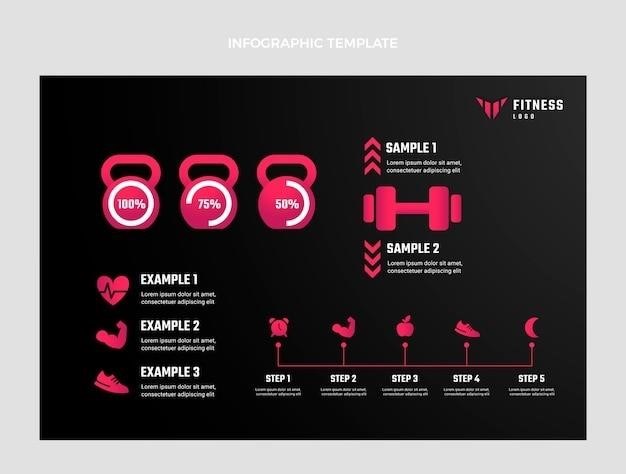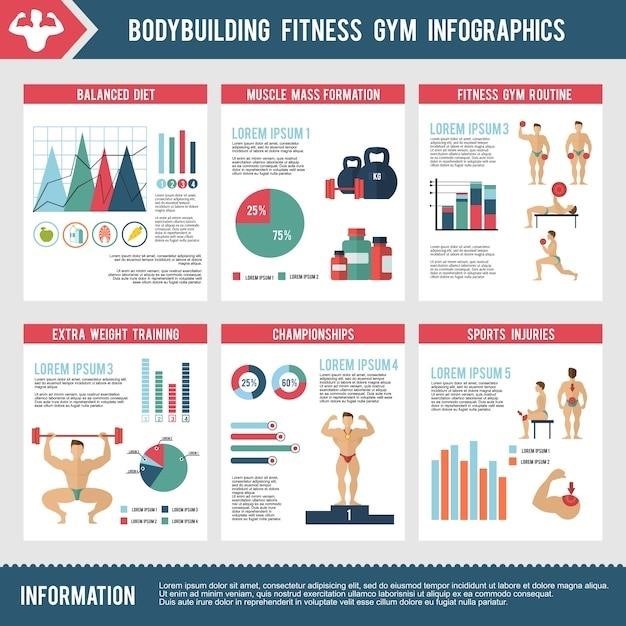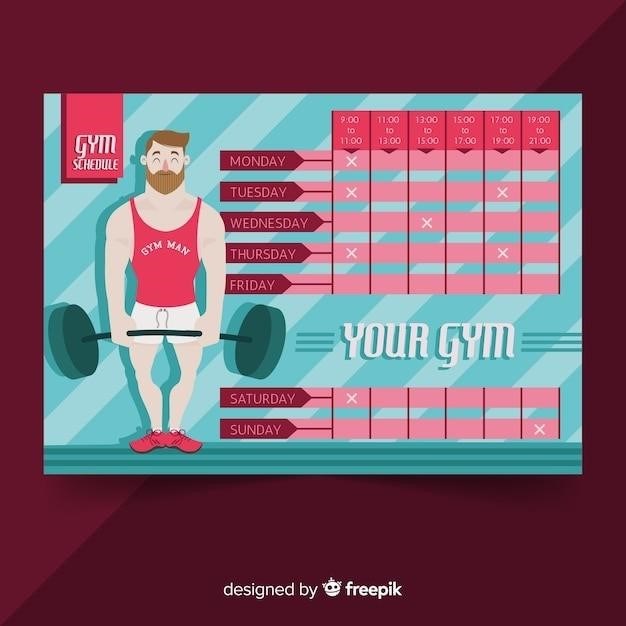Understanding Weightlifting Percentage Charts
Weightlifting percentage charts are crucial tools for tracking progress, determining appropriate weight loads based on your one-rep max (1RM), and optimizing training for various rep ranges and goals. They offer guidance, but individual factors should be considered for adjustments.
What is a Weightlifting Percentage Chart?
A weightlifting percentage chart is a valuable tool used by athletes to plan and track their strength training workouts. These charts display percentages of a lifter’s one-rep max (1RM) – the maximum weight they can lift for a single repetition – correlated to the corresponding weight for various rep ranges. The chart allows lifters to easily determine the appropriate weight to lift for a specific exercise based on their target rep range and percentage of their 1RM. This ensures that workouts are appropriately challenging and promotes effective strength gains. Many readily available PDFs offer these charts, providing a convenient reference for weightlifters of all levels. Using a weightlifting percentage chart simplifies workout planning and helps maintain consistency in training intensity.
Purpose and Benefits of Using a Chart
The primary purpose of a weightlifting percentage chart is to provide a structured approach to strength training by guiding weight selection based on your 1RM. This ensures workouts are appropriately challenging, promoting consistent progress and avoiding plateaus. Using a chart helps to track your progress over time, allowing you to monitor strength gains and adjust training accordingly. The charts provide a visual representation of your training intensity, making it easy to see where you are in a workout cycle. Furthermore, they streamline the workout planning process, eliminating the need for complex calculations during each session. This frees up mental energy to focus on proper form and exercise execution. Whether using a physical chart or a downloadable PDF, the benefits of structured weight selection and progress tracking are significant for weightlifting success.
Calculating Your One-Rep Max (1RM)
Accurately determining your one-rep max (1RM) is fundamental to effectively using a weightlifting percentage chart. Your 1RM represents the heaviest weight you can lift for a single repetition with proper form. While directly testing your 1RM is the most accurate method, it can be risky and requires careful planning. Alternatively, you can utilize online 1RM calculators. These calculators use your performance data from multiple repetitions at a lighter weight to estimate your 1RM. Several reputable online resources and fitness apps offer these calculators. Inputting your results from a set number of repetitions at a specific weight allows these calculators to estimate your 1RM, providing a safer and more convenient method for determining your maximum lifting capacity before employing a percentage-based weightlifting program. Remember that using an online calculator provides an estimate, and your actual 1RM might vary.

Types of Weightlifting Percentage Charts
Weightlifting percentage charts come in various formats⁚ standard charts showing percentages of 1RM, advanced charts incorporating rep ranges, and customizable charts allowing personalized adjustments to suit individual needs and training goals.
Standard Percentage Charts
Standard weightlifting percentage charts provide a straightforward representation of weight loads corresponding to percentages of your one-rep max (1RM). These charts typically list percentages in increments of 5% (e.g., 50%, 55%, 60%, etc.) up to 100%, alongside the calculated weight for each percentage. For example, if your 1RM for the bench press is 225 lbs, a standard chart will show that 85% of your 1RM is 191.25 lbs (225 x 0.85). The simplicity of these charts makes them ideal for beginners or those focusing on basic strength training. They offer a quick reference for determining appropriate weights for various exercises. While straightforward, these charts lack the nuance of advanced options.
Advanced Charts with Rep Ranges
Advanced weightlifting percentage charts go beyond simple percentage-to-weight conversions by incorporating rep ranges. These charts factor in the relationship between the percentage of 1RM and the number of repetitions you can perform at that weight. For instance, a chart might indicate that 75% of your 1RM allows for 5-8 repetitions, while 85% might only allow for 2-3. This added dimension is crucial for those designing programs around specific training goals, such as hypertrophy (muscle growth) or strength development. The inclusion of rep ranges allows for more precise weight selection to target specific training zones. These charts provide a more tailored approach to weightlifting, better aligning the load with the desired training effect.
Customizable Charts
For a truly personalized training experience, customizable weightlifting percentage charts offer unparalleled flexibility. Unlike standard charts with fixed percentages and rep ranges, customizable versions allow you to input your own 1RM for each exercise. This feature ensures the chart accurately reflects your individual strength levels, leading to more precise weight selection. Some customizable charts even let you adjust the percentage increments, allowing you to fine-tune your training based on your specific needs and recovery capacity. This level of personalization is invaluable for athletes with unique training requirements or those who prefer a more tailored approach. The ability to modify the chart’s parameters makes it a powerful tool for long-term progress and program optimization.
Using a Weightlifting Percentage Chart Effectively
Effective chart usage involves selecting the right chart for your goals, correctly interpreting percentage values and weight loads, and making necessary adjustments based on individual factors and progress.
Choosing the Right Chart for Your Goals
Selecting the appropriate weightlifting percentage chart hinges on your specific training objectives. Are you focused on strength gains, hypertrophy (muscle growth), or endurance? Strength-focused programs often utilize higher percentages of your 1RM (e.g., 85-95%), employing lower rep ranges (1-5 reps). Hypertrophy training typically involves moderate percentages (70-85%) with higher rep ranges (8-12 reps). Endurance training might use lower percentages (50-70%) and higher repetitions (15+ reps). Consider your experience level; beginners might benefit from starting with simpler charts focusing on fewer percentage increments, gradually progressing to more nuanced charts as they advance. The chart’s format—whether it’s a standard percentage chart, an advanced chart with rep ranges, or a customizable option—should align with your training plan’s complexity and your understanding of weight training principles. Always prioritize safety and listen to your body; adjust weights and rep schemes as needed. Incorrect chart selection can hinder progress or lead to injuries.
Interpreting Percentage Values and Weight Load
Understanding how to interpret a weightlifting percentage chart is key to effective training. The chart typically presents percentages of your one-rep max (1RM), representing the heaviest weight you can lift for a single repetition. For example, 80% of your 1RM means lifting a weight equal to 80% of your maximum capacity. This percentage dictates the intensity of your workout. Higher percentages indicate heavier weight and lower repetitions, ideal for strength development. Conversely, lower percentages mean lighter weight and higher repetitions, better for building muscle mass or endurance. To determine the actual weight, multiply your 1RM by the desired percentage. If your 1RM bench press is 200 pounds, and the chart recommends 75%, you’d lift 150 pounds (200 x 0.75). Accurately determining your 1RM is crucial for precise weight calculation. Some charts incorporate rep ranges alongside percentages, providing further guidance on set and rep combinations for different training goals. Remember, these are guidelines. Adjust based on your individual experience and recovery capacity.
Adjusting Based on Individual Factors
While weightlifting percentage charts offer valuable guidance, they are not one-size-fits-all solutions. Individual factors significantly influence how you should interpret and adjust the suggested weight loads. Your current fitness level, experience with weight training, and recovery rate all play crucial roles. Beginners should start with lower percentages than experienced lifters. If you’re recovering from an injury or illness, reducing the weight and focusing on proper form is essential. Listen to your body; if an exercise feels excessively strenuous or causes pain, decrease the weight or adjust the repetitions. Factors like sleep quality, nutrition, and stress levels can also impact your performance and recovery. Don’t hesitate to modify the suggested weights based on your overall well-being. Regularly reassess your 1RM and adjust the percentages accordingly as you progress. The charts provide a framework; your body’s feedback is the ultimate guide.

Finding and Utilizing Weightlifting Percentage Chart PDFs
Numerous websites and fitness resources offer downloadable weightlifting percentage chart PDFs. Choose reputable sources to ensure accuracy and reliable data for effective training.
Reliable Sources for Downloadable Charts
Securing accurate and dependable weightlifting percentage chart PDFs requires careful source selection. Look for established fitness websites, reputable strength and conditioning organizations (like the NSCA), or well-regarded online fitness communities. These sources often provide charts validated by experts, ensuring the data aligns with established training principles. Be wary of charts from unknown or less credible sources, as inaccuracies can hinder progress and potentially lead to injury. Cross-referencing information from multiple trusted sources can further bolster confidence in the chart’s reliability. Remember to check the chart’s date to ensure it is current; training methodologies and recommendations can evolve. Always prioritize your safety and consult with a qualified professional before implementing any new training plan.
Tips for Using Digital Charts
Utilizing digital weightlifting percentage chart PDFs offers convenience and accessibility. For optimal use, ensure your PDF viewer allows for zooming and easy navigation. Consider saving the chart to your device for offline access during workouts. If the chart is interactive (some offer weight calculations based on 1RM input), utilize this feature to streamline your weight selection process. Remember to adjust brightness or contrast settings on your device as needed to enhance chart readability, especially in dimly lit gyms. If you prefer a hands-free approach, consider using a tablet or smartphone mount to keep the chart visible during your lifts. Avoid unnecessary zooming or scrolling during sets to maintain focus on proper form and technique. The screen’s orientation may also affect visibility; experiment to find what works best for you.
Printing and Using Physical Charts
Printing your weightlifting percentage chart PDF provides a tangible reference readily available in your workout space. Choose high-quality printing for durability and clarity; consider heavier paper stock to withstand frequent handling and potential spills. Before printing, adjust the PDF’s scaling to ensure optimal size for your intended use; a larger print might be better for easy readability from a distance. Laminating the printed chart adds significant protection against wear and tear, moisture, and accidental damage. Once printed and possibly laminated, find a convenient location in your gym or home workout area; a wall-mounted chart is ideal, but a sturdy, easily accessible surface will also work well. Consider using protective sleeves or a clear cover to further extend the chart’s lifespan. Remember to keep the chart clean and free from debris; a quick wipe-down with a damp cloth is all it usually takes.
